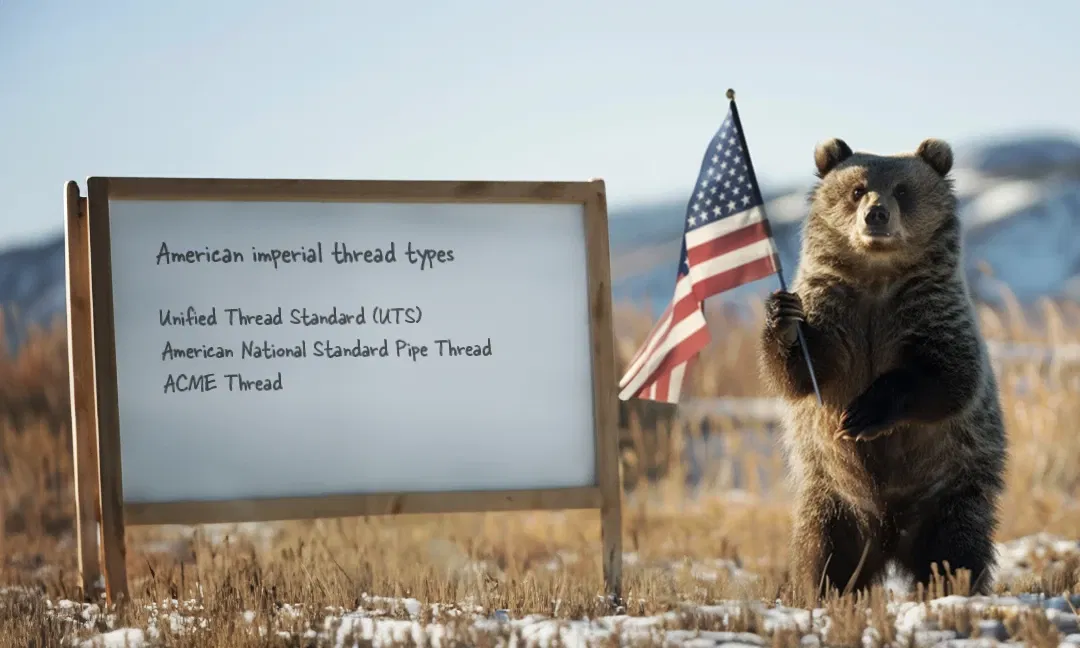
These are the most important inch thread types from the USA
The USA is known as the land of inventors, engineers and innovators. It goes without saying that threads, in all their variety and abundance of forms, played a major role here early on. Great Britain is officially the cradle of the thread standard - it was there in 1841 that Joseph Whitworth came up with the idea that national standards would be quite practical. But the USA followed suit shortly afterwards with its own designs and, of course, everything was bigger and better here than anywhere else.
Today, there are numerous American inch thread types, all with their own advantages and disadvantages and sometimes very specific areas of application. It's not always easy to keep track of them all. Why should you try anyway? Because you may encounter American thread types at any time, even in this country. Components from the USA or other countries outside Europe often make a basic understanding indispensable. And in some areas, such as photography, imperial American threads are also the standard within Europe. So let's delve into the world of American thread types and take a closer look at what they are all about.
What you need to know about imperial American thread types
The differences to the metric standard thread are not even that great for many American inch thread types. This is due to the flank angle, which is 60° for most thread types both here and on the other side of the pond. However, this does not mean that metric and imperial American thread types are interchangeable.
The biggest difference lies in the unit of length used, the inch. One inch corresponds to 2.54 cm. The term inch is also often used, which is the English term for inches. You can use both terms equally. The unit is often abbreviated to ″ or in for inch. Partial specifications are not made using commas as with decimal numbers, but are given as fractions.
A little practice is also required when dealing with the pitch of imperial American threads. While the distance between two thread tips is specified as the pitch for standard metric threads, you will usually see the term threads per inch (TPI) in thread tables for imperial American threads. For American thread types, this simply means the number of threads per inch of thread length.
These American inch thread types exist
There are three major groups of imperial American thread types that you need to distinguish. The Unified Thread Standard includes various standards for fastening bolts and nuts and other components. The National Pipe Thread includes the standards for American pipe threads. And the ACME thread types are American trapezoidal thread types frequently used as movement threads.
Unified Thread Standard (UTS)
The system of UTS threads is initially a little intimidating due to its enormous bandwidth, but is actually very logically structured. At its heart is the trio of coarse thread and two fine threads, which can be roughly equated with the familiar duo of metric standard thread and fine thread. The designations are UNC (Unified National Coarse = coarse thread), UNF (Unified National Fine = fine thread) and UNEF (Unified National Extra Fine = fine thread with particularly small pitch). As you can see, there are two gradations of fine thread in the UTS threads.
The UTS also includes a series of American thread types with a constant pitch of 4 TPI, 6 TPI, 8 TPI, 12 TPI, 16 TPI, 20 TPI, 28 TPI and 32 TPI. The designation for this series is UN with the corresponding pitch in front, e.g. 8-UN. Some special combinations of diameter and pitch are also covered by the UNS (Unified National Special) thread.
And finally, there are some special forms such as the miniature thread UNM, the UNR thread with a rounded thread base or the J-series for aerospace applications.
American National Standard Pipe Thread
There are also numerous American pipe thread types, some of which are intended for very specific purposes. A distinction is made between cylindrical and tapered pipe thread types. The cylindrical thread types can be recognized by the letter S for straight in the thread designation, while the letter T for taper indicates tapered threads.
The most common and usable for all normal applications is the normal tapered pipe thread National Pipe Taper (NPT). It is non-sealing and requires additional sealant. The NPTF (National pipe taper fuel and oil) variant, on the other hand, is sealing in the thread. It is often referred to with the suffix Dryseal to express this property.
The National Pipe Straight (NPS) cylindrical pipe thread can either be combined with another NPS thread or with an NPT thread. There are numerous special forms of the NPS thread for different areas of application, such as the NPSF (National pipe straight fuel and oil), the NPSH (National pipe straight hose) or the NPSM (National pipe straight mechanical).
ACME thread
The ACME thread is a trapezoidal thread that is usually used as a movement thread, for example to transfer forces and movements. It is similar to the metric trapezoidal thread - except for the flank angle. While the metric trapezoidal thread has a flank angle of 30°, the ACME thread has a flank angle of 29°. A small difference, but enough to make the two trapezoidal threads incompatible.
The ACME thread is available in three different versions. The most commonly used is the variant for normal applications, the General Purpose ACME thread. The STUB-ACME thread has a shallower thread depth and is used for thin-walled components, for example. And then there is the Centralizing ACME thread with tighter tolerances, which prevents wedging on long threaded spindles.
Do you need taps for imperial American thread types? You are guaranteed to find what you are looking for in our BAER online store. And for more information and in-depth purchasing advice, please contact our customer service team.
